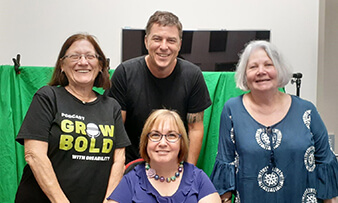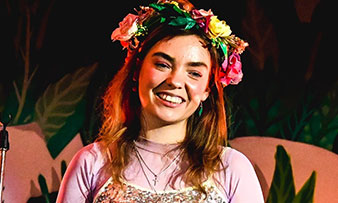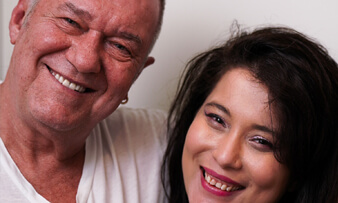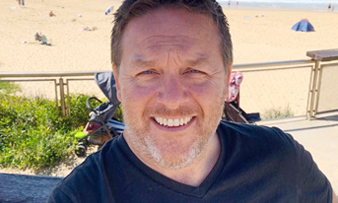- Home
- Grow Bold Podcast
- Season One
- Episode 7: Growing Bold using Virtual Reality
Growing Bold using Virtual Reality
with Angus McConnelIn this episode we’ll discover what happened to Angus, how he became a C7 quadriplegic, his struggles and how virtual reality has helped his rehabilitation.
Angus became a C7 quadriplegic after a cycling accident in 2013. He lives by the motto Never.Give.Up.
Duration: 21 minutes
Release date: 1 April 2020
Produced by: Black Me Out Productions
Virtual Reality & Rehabilitation
Learn more about Rohan O'Reilly
Pete: Welcome to the Grow Bold with Disability podcast, brought to you by Feros Care. A podcast dedicated to smashing stereotypes and talking about the things people with disability care about most. To help us live bolder, healthier, better connected lives. I’m journalist, Pete Timbs.
Tristram: And I’m Tristram Peters. I work for Disability Service Directory, Clickability and am a wheelchair user living with spinal muscular atrophy.
Pete: Today’s episode of Grow Bold with Disability is growing bold using Virtual Reality and our guest is Angus McConnel, an old mate of mine who became a C4 quadriplegic after a cycling accident in 2013. In this episode we’ll discover what happened to Angus, his struggle with being a quadriplegic and how virtual reality has helped his rehabilitation. Gus, welcome to Grow Bold with Disability.
Angus: Thanks, Pete. Hey, Tristram.
Tristram: Gidday.
Pete: Now mate, let’s head back to 2013. Tell us about that fateful day.
Angus: I was riding my pushbike down a hill here in Newcastle, Memorial Drive it’s called, and it leads down to Cooks Hill Surf Club. It’s a pretty steep hill and you roll about 60 on your pushbike down there. A car came up the other way and paused as I was coming down the hill, and then turned across me as I got there. I ended up having a bit of a collision with that car and writing it off.
Pete: Jeez, oh my God, so just you weighted 85 kilos coming down the hill at 60, totalled a car?
Angus: Calm down with 85 kilos, Pete, I was fit.
Tristram: So, Gus, what was the initial diagnosis? You obviously went to hospital. What was the diagnosis that you got?
Angus: At the back of the ambulance I was awake and they were asking the usual questions, can you feel this, and I couldn’t but at that point that’s way too early and you’re not thinking, I’m going to be a spinal cord injury. Then in hospital I was pretty banged up, as you can imagine, I spent a lot of time on a resus machine, so I couldn’t talk to my family and friends, who were all visiting. Yes, I had a tube down my throat which, as you probably understand, Pete, was a drastic change for me, not being able to talk.
Pete: The most peace your family’s had in years, I reckon.
Angus: Yes, somewhat, a little bit of a shock. In hospital you learn pretty quickly what you can and can’t do. There’s a little thing called shock that you may come out of it, but basically, I can move my arms, but can’t clench fists properly. Essentially, I was diagnosed at the time C7 complete and still am, but I had a syrinx later on about six months down the track, which is a little bit of a problem that means it puts pressure on the spinal cord, and then I graduated to C4 sometime later.
Pete: How was your mental state with this? We obviously know your physical state, Gus. What was going through your head after your diagnosis and then, as it went by and you could see this is pretty permanent?
Angus: Yes, it’s a pretty horrible time, look, it is, it’s drastic. But fortunately, in my state of mind, you land in hospital, I spent about eight weeks down at Royal North Shore Hospital. Sorry, firstly, in Newcastle Hospital for a week, where they did an operation which turned out didn’t quite work and so I went down to Royal North Shore or got halfway down in a helicopter, actually, and turned back because it was too windy to land. I ended up at North Shore after a good time and you’re in a ward full of people with spinal cord injury, essentially.
It's harrowing, but there’s people around you who are going through the same ordeal, I guess. For me, being a 41 year old fella with a family, a young family at that, it gives you drive to keep going and push on. Yes, you just need to. There were some older guys there who, hats off to them, I don’t know what kept them going because, mate, it crushes you to find out that what you’ve been doing for 40 years, all of a sudden you can’t do anymore.
Tristram: Yes and, Gus, you mentioned your family there, what effect did this have on your relationships with your family and friends? Was there a difference?
Angus: Yes, certainly. Physically is the biggest impact. Mentally, yes. There’s a lot to deal with physically. All of a sudden you can’t go to the toilet by yourself, let alone walk down the street. You can’t stand up at a pub. This is obviously much further down the track, but you can’t stand up and interact socially with people at a party or even a gathering. In those situations where everyone stands up all the time, it’s really frustrating.
Your diaphragm is squashed all day because you’re sitting down, so you’ve got to yell with lungs and a diaphragm that don’t work properly, so your voice box is inhibited. My usual loud voice isn’t that anymore, and you’re yelling up to people who are talking down at you. It’s really frustrating. Imagine sitting in the pub, sitting there while everyone else around you is standing. It’s very frustrating, I don’t like that.
Tristram: Absolutely.
Pete: Gus, when you got out of hospital and you came to grips with what was going on, let’s say, 12 months down the track, what did the doctors say your future held for you?
Angus: The message was very much, essentially, from my nipple line down, forget about that. Look after it, but you won’t be using that again, and concentrate on what you’ve got. A little bit of arm movement which I’m very fortunate in my position, my biceps and triceps move. Tristram, you probably understand that I can pull my arms back to a position, so I push myself around in a normal chair, a push chair, rather than being in an electric chair.
Tristram: Yes, absolutely and, on that, obviously the doctors are giving you this sort of feedback and it was around then that you decided to look into alternative therapies. Where did you go down that path?
Angus: Yes, that’s right, it was about a year down the track. I’ve remained pretty positive to try and be, without sounding too corny, be all that you can be, sort of thing. Keep pushing, only seven years ago, knowing that technology would be coming. And then it’s difficult to find. As you’re probably aware, mainstream medicine was really quite shut to trying to push to help to do anything, so what you do, you look outside the box.
I found a fella called Rohan O’Reilly, who all he does is think outside the box, this fella. He’s an amazing chap and his technical mind and his empathy as well, mate, the guy is absolutely unbelievable. He came up with the idea of using all kinds of technologies on me, and I’m open to it because he’s getting results.
I can now move my foot, certainly after a little bit of stimulation in my feet. Then we turn everything off and strip me down and all I’ve got is my brain doing the work. I can move my foot, I can pull my feet back in dorsiflexion now and it’s pretty amazing to see that come along, considering I wasn’t able to do that.
Tristram: Fantastic.
Pete: Rohan’s a movement therapist. How has he got you to this point? What’s he doing that’s different to everyone else?
Angus: We use all manner of technology from a hard bristled brush to, essentially, a well rounded and crafted stick, a nice little piece of timber, so high level stuff. Then we also move a little bit further down the historical pages and use electronic gadgets. Stim machines, electronic stimulation. A machine borne out of American military technology, which was to get their guys back up and walking, a thing called the Parastep machine.
If you can imagine a TENS machine that you might have had on an ankle injury or something, and you turn that up to ten, that’s really quite uncomfortable. That machine pumps out about 50 milliamps of power, that’s just so you might be able to relate to it, 10 to 50 milliamps of power in a TENS machine.
The next thing we use is a MyoPlus, which is a really souped up TENS machine, essentially, and it’s got varying programmes. It’s got 90 milliamps of power, so it can really throw some stuff out, but the difference in Parastep is that where the electrodes are touching your skin, each electrode will do something at a different time.
On a TENS machine or the MyoPlus, any programme that you’re using, all the power goes at the same time, so drumbeats are all happening at the same time on your skin. The Parastep works it a little bit differently and, mind you, just to put the milliamps on a Parastep machine, crank that up to ten and you’re 250 milliamps of power.
Pete: Whoa.
Angus: Yes, make a horse jump a fence, sort of thing, it’s a powerful machine. What it does, it’s got sit to stand function and it pumps at your gluts first and then your quads will kick in after that and then your peroneals, which lock your knees into joint, they kick in afterwards, so you stand up with the thing. It’s a good bit of gear.
Tristram: You mentioned the pub earlier, going to the bar. Have you used that stand chair at the pub before?
Angus: No, I think I’d throw myself out of my chair and fall over and knock stools over, and then very unhappy people with schooners going everywhere.
Tristram: That’s fair.
Angus: No, I haven’t tried that yet, but we do, do that. What it does is it has pumped my legs up and kept them, essentially, preconditioned to accept any of the technology that’s coming, as far as stem cell, and we’re so close. There’s trials, I believe, happening up in Queensland this year, so I’m looking to get involved with that too. What it’s done is keep me preconditioned. My legs look like probably a lot stronger than Pete’s legs there.
Pete: Turn it up.
Angus: Yes. Look, I wasted away in hospital, so I had nothing. I’m built back now to not quite what I was, but certainly looking half normal.
Pete: Mate, tell us about the virtual reality therapy, how that works?
Angus: One of the other things we use with Roh at Engage VR, sorry to plug there, but that’s what the company’s called that he’s working with. At Engage, VR is used and it couples with... As you know, VR with gaming, all of that sort of stuff, you’ve got all kinds of haptic technology, which now you can put a glove on and as you’re pulling the trigger you’ll feel a bit of recoil in a gun or you can feel a butterfly or a sparrow land on your finger. That haptic technology is enabling people to feel a little bit of what’s happening and what’s going on, to authenticate the experience under VR.
What Rohan thought about with VR was we can use that in therapy, and what we can get out of that is, essentially, I’m just going to sidestep here a little bit. Someone has a stroke and the left side of their body traditionally gets injured or stops working, essentially. There’s a technique that they use very frequently with the recovery of stroke called a Mirror Box. You put your arm in the Mirror Box and you put your right arm down next.
Your left arm goes in the Mirror Box, your right arm goes down next to the Mirror Box, and you start moving your right arm and obviously your brain can see your right arm moving and it can see now the reflection of your right arm moving, which looks like your left arm, and it reboots your brain into, right, my left arm moves and then all of a sudden it will start moving. VR, have you been into VR, you guys?
Pete: I’ve used it once or twice.
Tristram: Likewise.
Angus: Certainly, the people out in podcast world may have tried VR. If not, go and try it and if you can, put earphones on as well. Look at how amazing the feeling that comes back out, as you come of VR. It’s a total sensory involvement in the experience, which is quite amazing. You go in there and you can see that it’s cartoon land and all you might be doing is pulling a bow and arrow and shooting some little guys who are attacking your castle, say. Or shooting some zombies or riding a unicorn and flapping the wings and riding a bike, so you can do all those things.
You come out of this cartoon land and you go, oh, that’s right, I’m not in cartoon land, I’m back in the real world, and it feels like you’re in a cartoon. Rohan had a go at that and thought, this is going to be an absolute gamechanger for the world of neuroscience, in that you’re totally immersed in there. Not dissimilar to the Mirror Box technique, VR is helping you trick your brain into thinking, this is what I can do.
All of a sudden you put gloves and legs on and you can go for a walk in VR if you’re harnessed up, and you can go for a walk on a treadmill or down a track that Rohan is having set up at the moment. We can move my body with the Parastep on as well. We can move my body, I can look down in VR and see my legs moving. That’s going to trick my brain, we think, somewhat into helping my brain and central nervous system reboot somewhat and start working, and certainly grow the neural pathways and regrow like we know that happens at the moment.
Tristram: It’s amazing what’s happening. How far do you think this is before becoming mainstream and becoming regular practice?
Angus: Oh, look, I think the evolution has begun. Another place that I go to physio, it’s a neuro rehab physio gym, essentially, where all the gang there are qualified physios, exercise physiologists etc. It’s completely accessible and those guys are training, it’s physios doing the work. I stand up with them without any of the electronic equipment.
I push myself off the end of a plinth, essentially, and one of the girls locks my knees in mechanically and she sits behind me and holds me up, and we stand there, which is all good for all manner of things, muscle stretching, bone density, etc. The list goes on. We’re built to stand up, we need to keep standing up.
Pete: Gus, what do you see the future holding? You spoke about they’re doing a lot of stuff with stem cells.
Angus: Yes.
Pete: What are you hearing there? The combination of this, of all this technology. Where do you see this in ten years?
Angus: In ten years, mate, I’ll be walking.
Pete: Amazing.
Angus: I think it won’t be too long. I can’t put a date on it, but I think you’ll go into hospital as a spinal cord injury and you’ll be walking out the door. I think that’s where it’s heading. Obviously, mainstream medicos need to get on board. I think the younger generation... I have carers, I have fulltime care. When I say fulltime, I need someone to get me up in the morning, I need someone to put me to bed at night.
I need someone to help me go to the toilet and to shower etc. The guys I use mostly are uni students who are coming through as physios and OTs and nurses, and most recently I’ve had a doctor, and here they come. The next generation will want to be fixing people, not just patching them up and sending them on their way, I think.
Tristram: It’s amazing. It’s phenomenal to see what’s happening, and kudos to advances in medicine, it’s brilliant.
Pete: Gus, as you know, this podcast is called Grow Bold with Disability, mate. We’d like to finish off with you telling us what living a bold life is to you?
Angus: Mate, I’ve kept doing things to... My family are growing up. I’ve got a 13 year old son who’s the youngest, two that are older than that. Go and break the boundaries that not only society might be putting on you, but the ones that you’re putting on yourself. Go and put yourself out of your comfort zone. Since I’ve been in the chair we’ve been all over the world. Most recently in Hawaii I’ve paddled an outrigger canoe in the surf. I’ve jumped out of a plane with my sister on my back. Obviously, Pete, you know that.
Pete: Yes.
Angus: Just keep living life.
Pete: Gus, you’re an absolute inspiration, mate. Thanks so much for joining us here today on Grow Bold with Disability podcast brought to you by Feros Care. Our listeners can find out more about Gus and his incredible journey in links provided in today’s episode show notes. Mate, thanks again so much, Gus.
Tristram: Cheers, Gus.
Angus: No worries, boys, thanks for having me.
Pete: Thank you for listening and if you have enjoyed today’s episode, then make sure you subscribe to the podcast, Grow Bold with Disability. If you like what you heard, then please take a few moments to pop over to iTunes and give our podcast a quick rating, so we can continue these conversations and encourage people to grow bold.
This podcast is brought to you by Feros Care, a people care organisation committed to helping people live bolder lives. We call it Growing Boldly and for over 25 years Feros has been making it real for both older Australians and those living with disability. To find out more, head to feroscare.com.au.
The content and views discussed in this podcast series are those of the individuals involved. They are not necessarily condoned by, or, are the views of Feros Care or its employees.
Latest episodes

Debunking the statement that people with disability don't make good employees
with Jo Lynam, Karene Gravener and Erica Hahn

Growing Bold and Neurodiversity
with Chloe Hayden







